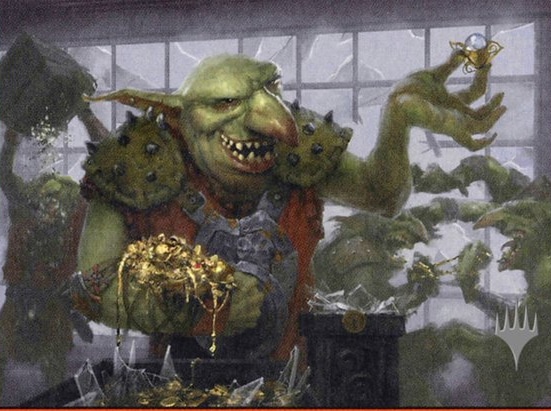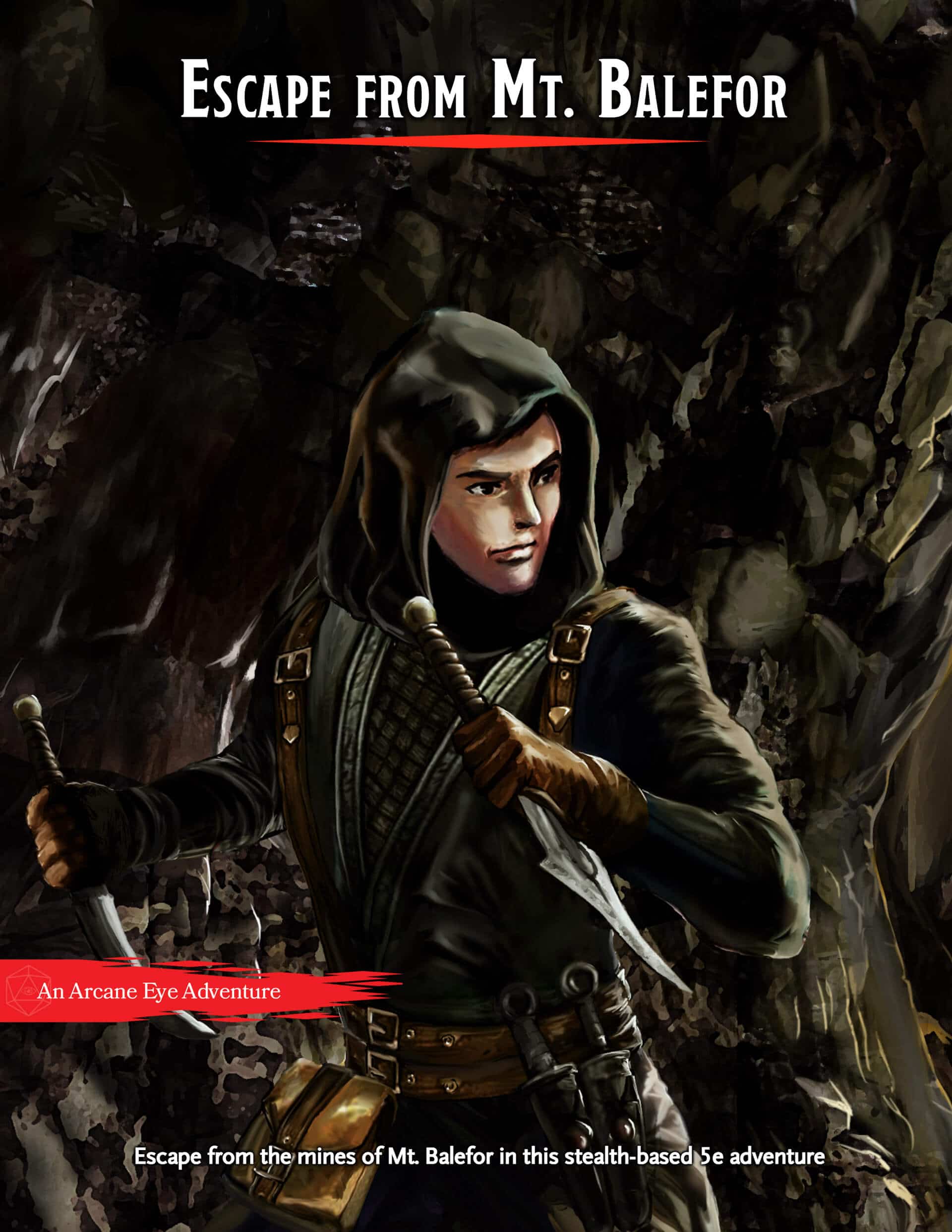Goblin Guide 5e
Published on December 11, 2020, Last modified on May 2nd, 2022

Krenko, Tin Street Kingpin - Wizards of the Coast - Mark Behm
Arcane Eye may earn a small commission from affiliate links in this article.
Learn more.What is this guide?
This guide is meant to give you an idea of whether or not the goblin will be right for your 5e character build.
The color code below has been implemented to help you identify, at a glance, how good that option will be for your goblin. This color coding isn’t a hard and fast rule; there are plenty of sub-optimized options out there that will be viable to your party and will be fun to play.
- Black is a trait shared by many races and or will not impact the effectiveness of your character build
- Red isn’t going to contribute to the effectiveness of your character build at all
- Orange Situationally good, but a below-average option otherwise
- Green is a good option
- Blue is a great option, you should strongly consider this option for your character
- Sky Blue is an amazing option. If you do not take this option your character would not be optimized
Tasha's Cauldron of Everything Update
Tasha's Cauldron of Everything has added the "Customizing Your Origin" option that may affect the ability score increases, languages, and proficiencies in this guide. To read more about this, visit our D&D Race Guide.
What are Goblins in 5e?
Source: Volo's Guide to Monsters
Originally the cliché monster intended for a campaign’s first low-level combat encounter, goblins became a playable race in Volo’s Guide to Monsters. They are small, evil humanoids that typically live together in caves, venturing out to ambush unsuspecting prey. As self-serving as they are greedy, travelers should always be wary of encountering goblins.
With the addition of goblins as a playable race in D&D 5e, there is a whole new avenue for roleplaying and storytelling that playing a monster brings to the table. If your goblin has had different life experiences, it is completely reasonable to play one as an able member of an adventuring party.
Goblin 5e Traits
Ability Score Increase: DEX is an extremely common ASI, but is useful to most builds to, at the very least, bolster AC. The same goes for CON. Together, these ASIs are good for DEX dependent builds that want some durability.
Age: Goblins grow up fast but do not live especially long. Aging magic could be harsh.
Alignment: As expected, goblins lean towards being evil.
Size: A Small size comes with some drawbacks, such as wielding certain weapons and grappling. On the other side, Small creatures are better at hiding and can more easily move around the battlefield.
Speed: Maintaining a standard walking speed is great considering that goblins are Small creatures.
Darkvision: Darkvision is always great, but its advantage can be ruined if your party members do not also have it.
Fury of the Small: Fury of the Small is great against single targets. It scales as you level and will work against most creatures since they will likely be larger than you, but sadly it can only be used once per Short Rest.
Nimble Escape: More uses for the bonus action is excellent, especially as a melee or sneaky character. As a rogue, Nimble Escape is completely useless because it is essentially Cunning Action with fewer available actions.
Languages: Speaking Goblin is pretty niche.
Goblin 5e Subraces
Updated
In the Monsters of the Multiverse update, goblins are now descended from the fey and have had their main ability, Fury of the Small, reworked.
Darkvision: This is the same as the original goblin.
Fey Ancestry: Advantage against being charmed and being unable to be put to sleep by magic will come in handy in some tough situations.
Fury of the Small: Now that Fury of the Small can be used an equal number of times to your proficiency bonus per day, and the damage is also equal to your proficiency bonus, the maximum damage you can deal would be 6 x 6 = 36 per day when you achieve +6 proficiency bonus at level 17. In comparison, the original Fury of the Small could be used once per rest. The Dungeon Master’s Guide considers a typical adventuring day to consist of one long rest and two short rests. At 17th level, this would mean that a goblin could deal an extra 17 x 3 = 51 damage per day. Not only did the original Fury of the Small deal more damage in a day, it also could do so in far fewer attacks, making it much more efficient. This change is a significant downgrade.
Nimble Escape: This is the same as the original goblin.
Which 5e Classes Work With Goblins?
The goblin’s stat spread doesn’t lend itself to being optimized for anything other than DEX-dependent character builds.
Artificer: Artificers need INT to be effective.
- Updated: Now that goblins can choose INT they are a solid pick for an artificer. Nimble Escape is good so you don't get caught in melee range if you are playing a squishy subclass, and Fury of the Small gives a solid damage boost whether you are playing a melee artificer or focus on damage dealing spells.
Barbarian: Barbarians need STR to be effective.
- Updated: You do get the bonus damage from Fury of the Small, but nothing else is very appealing here for a barbarian as they typically don't want to run and hide.
Bard: Bards need CHA to be effective.
- Updated: Melee as well as spell-based bards will benefit from the boosted damage by way of Fury of the Small as many of their best spells are focused on support and crowd control rather than raw damage. Nimble Escape will come in handy as bards aren't known for their ability to tank damage.
Cleric: While there are Cleric builds centered around DEX, the lack of WIS is a steep price to pay.
- Updated: Clerics are an excellent candidate for the updated goblin as they receive a boost to their spell and weapon damage with Fury of the Small, and can use Nimble Escape to move into position to save their allies with a spell or distract enemies.
Druid: Druids need WIS to be effective.
- Updated: A strong choice for any Circle of the Moon druid who will be able to take full advantage of Fury of the Small and Nimble Escape. Fury of the Small is less useful to the other subclasses if your druid isn't focused on dealing damage in battle, but Nimble Escape is perfect to get out of sticky situations as druids are quite squishy.
Fighter: Goblins are right at home for DEX-based fighter builds. The goblin’s racial traits add extra movement options and boosted damage. STR-based fighters are better off choosing a different race.
- Updated: The new goblin is perfect for the fighter, allowing you to choose your ASIs depending on your preferred weapons. Fury of the Small gives boosted damage to any of the attacks you wish, and Nimble Escape makes your fighter much more maneuverable on the battlefield, able to disengage an enemy without provoking attacks of opportunity.
Monk: DEX and CON are a great start for a monk build as they need a high AC and hit points to survive in melee range. Nimble Escape works well with this class, but may not get much use as monks have many powerful options for their Bonus Action.
- Updated: Monks can already Disengage with Step of the Wind, though Fury of the Small will add some damage to the many attacks monks can take per round.
Paladin: Because paladins rely on several ability scores, a lack of both STR and CHA is not ideal. Despite this, DEX and CON are still useful and the goblin’s racial traits add extra movement options and boosted damage.
- Updated: Paladins do get the boosted damage from Fury of the Small, but hiding and disengaging isn't typically what they want to be doing.
Ranger: Goblins are a great choice for rangers. The DEX and CON ASI spread is second only to races with DEX and WIS. The goblin’s racial traits all increase the effectiveness of the class.
- Updated: Nimble Escape will be very useful to stay away from your enemies if using a bow, and even melee rangers will make use of it as they aren't as tanky as some other classes. Fury of the Small will stack nicely with Hunter's Mark and other ways to boost damage since rangers don't get many extra attacks.
Rogue: Nimble Escape is useless as a rogue due to Cunning Action. The DEX and CON boosts are what rogues want but there are other races that have similar ASIs and better racial traits.
- Updated: Nothing has changed enough to make the updated goblin better than the original for a rogue.
Sorcerer: Sorcerers need CHA to be effective.
- Updated: Now that goblins can choose CHA they are a solid pick for a sorcerer. Fury of the Small will add damage to all of your spells and Nimble Escape is a great failsafe to get out of harms way if you find yourself within melee range.
Warlock: Warlocks need CHA to be effective.
- Updated: Now that goblins can choose CHA they are a solid pick for a warlock. Fury of the Small will add damage to all of your spells and Nimble Escape is a great failsafe to get out of harms way if you find yourself within melee range. Goblins are also now a strong choice for Hexblades for boosted weapon damage and more maneuverability on the battlefield.
Wizard: Wizards need INT to be effective.
- Updated: Now that goblins can choose INT they are a solid pick for a wizard. Fury of the Small will add damage to all of your spells and Nimble Escape is a great failsafe to get out of harms way if you find yourself within melee range. Goblins are also now a strong choice for Bladesingers for boosted weapon damage and more maneuverability on the battlefield.
Sources Used in This Guide
- BR: Basic Rules
- GotG: Bigby Presents: Glory of the Giants
- SotDQ: Dragonlance: Shadow of the Dragon Queen
- ERLW: Eberron: Rising from the Last War
- EEPC: Elemental Evil Player’s Companion
- EGtW: Explorer’s Guide to Wildemount
- FToD: Fizban's Treasury of Dragon
- GGtR: Guildmasters' Guide to Ravnica
- MotM: Monsters of the Multiverse
- MToF: Mordenkainen’s Tome of Foes
- MOoT: Mythic Odyessys of Theros
- PAitM: Planescape: Adventures in the Multiverse
- PHB: Player's Handbook
- SAiS: Spelljammer: Adventures in Space
- SCoC: Strixhaven: A Curriculum of Chaos
- SCAG: Sword Coast Adventurer’s Guide
- TCoE: Tasha’s Cauldron of Everything
- TTP: The Tortle Package
- WBtW: The Wild Beyond The Witchlight
- VRGtR: Van Richten's Guide to Ravenloft
- VGtM: Volo's Guide to Monsters
- XGtE: Xanathar’s Guide to Everything
Fill out the form below to receive Escape From Mt. Balefor for free!
Or follow us on Instagram, Twitter, and YouTube.
Roland Drews
Roland Drews is a content creator and editor at Arcane Eye. When he isn't watching basketball or noodling on his guitar, you can find Roland reading, writing, or playing D&D. He currently lives in Bonn, Germany with his girlfriend Jess.

